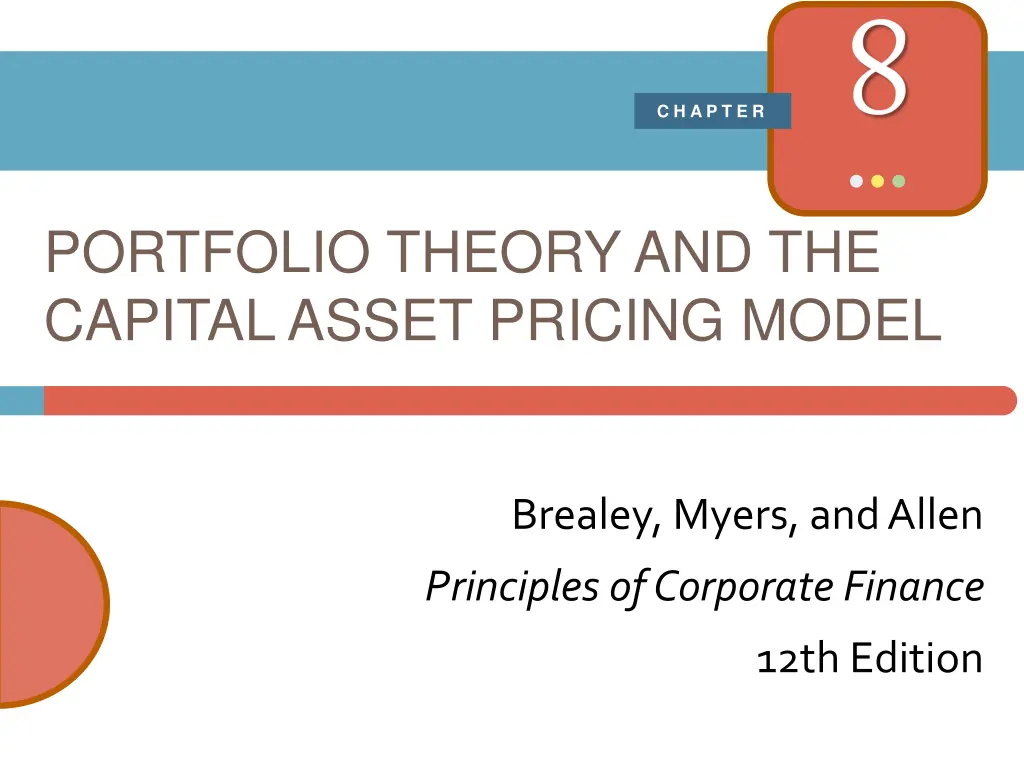
Portfolio Theory and CAPM in Corporate Finance
"Explore the foundations of Portfolio Theory and the Capital Asset Pricing Model (CAPM) as outlined in Brealey, Myers, and Allen's Principles of Corporate Finance 12th Edition. Delve into topics like Harry Markowitz's contributions, risk and return relationships, and efficient portfolios. Understand how Markowitz Portfolio Theory enables the reduction of standard deviation through stock combinations, leading to the creation of efficient portfolios. Witness the interplay between price changes, expected returns, and standard deviations, culminating in the concept of the Efficient Frontier."
Download Presentation

Please find below an Image/Link to download the presentation.
The content on the website is provided AS IS for your information and personal use only. It may not be sold, licensed, or shared on other websites without obtaining consent from the author. If you encounter any issues during the download, it is possible that the publisher has removed the file from their server.
You are allowed to download the files provided on this website for personal or commercial use, subject to the condition that they are used lawfully. All files are the property of their respective owners.
The content on the website is provided AS IS for your information and personal use only. It may not be sold, licensed, or shared on other websites without obtaining consent from the author.
E N D
Presentation Transcript
C H A P T E R PORTFOLIO THEORY AND THE CAPITAL ASSET PRICING MODEL Brealey, Myers, and Allen Principles of Corporate Finance 12th Edition
Topics Covered Harry Markowitz and the Birth of Portfolio Theory The Relationship between Risk and Return Validity and the Role of the CAPM Some Alternative Theories
Markowitz Portfolio Theory Combining stocks into portfolios can reduce standard deviation, below the level obtained from a simple weighted average calculation Correlation coefficients make this possible The various weighted combinations of stocks that create this standard deviations constitute the set of efficient portfolios
Markowitz Portfolio Theory Price changes vs. Normal distribution IBM - Daily % change 1994-2013
Markowitz Portfolio Theory Standard Deviation vs. Expected Return
Markowitz Portfolio Theory Standard Deviation vs. Expected Return
Markowitz Portfolio Theory Standard Deviation vs. Expected Return
Markowitz Portfolio Theory Expected returns and standard deviations vary given different weighted combinations of the stocks
Efficient Frontier Three efficient portfolios all from the same 10 stocks
Efficient Frontier Each half egg shell represents the possible weighted combinations for two stocks. The composite of all stock sets constitutes the efficient frontier Expected Return (%) Standard Deviation
Efficient Frontier Lending or borrowing at the risk free rate (rf) allows us to exist outside the efficient frontier.
Efficient Frontier Return B A Risk (measured as s)
Efficient Frontier Return AB B A Risk (measured as s)
Efficient Frontier Return B N AB A Risk (measured as s)
Efficient Frontier Return B ABN N AB A Risk (measured as s)
Efficient Frontier Goal is to move up and left. WHY? Return B N ABN AB A Risk (measured as s)
Efficient Frontier Goal is to move up and left. The ratio of the risk premium to the standard deviation is called the Sharpe ratio: WHY? r r p f = Sharpe ratio p
Efficient Frontier Low Risk High Risk High Return High Return Return Low Risk High Risk Low Return Low Return Risk
Efficient Frontier Low Risk High Risk High Return High Return Return Low Risk High Risk Low Return Low Return Risk
Security Market Line Return . Market return = rm Market Portfolio rf Risk free return = (Treasury bills) Risk
Security Market Line Return . Market return = rm Market Portfolio rf Risk free return = (Treasury bills) 1.0 BETA
Security Market Line Return . Security Market Line (SML) rf Risk free return = (Treasury bills) BETA
Security Market Line Return SML rf BETA 1.0 SML Equation = rf+ (rm rf)
Capital Asset Pricing Model = ( + ) r r r r f m f CAPM
Expected Returns These estimates of the returns expected by investors in November 2014 were based on the capital asset pricing model. We assumed 2% for the interest rate rfand 7% for the expected risk premium rm rf.
SML Equilibrium In equilibrium no stock can lie below the security market line. For example, instead of buying stock A, investors would prefer to lend part of their money and put the balance in the market portfolio. And instead of buying stock B, they would prefer to borrow and invest in the market portfolio.
Testing the CAPM Beta vs. Average Risk Premium
Testing the CAPM Beta vs. Average Risk Premium
Testing the CAPM Return vs. Book-to-Market http://mba.tuck.dartmouth.edu/pages/faculty/ken.french/data_library.html
Arbitrage Pricing Theory Alternative to CAPM = + + + + + Return ( ) ( ) ( ) .... noise a b factor r b factor r b factor r 1 1 2 2 3 3 = Expected premium risk r r f = + + ( ) ( ) ... b factor r r b factor r r 1 1 2 2 f f
Arbitrage Pricing Theory Estimated risk premiums for taking on risk factors (1978-1990) Estimated Risk Premium r f Factor ( ) factor r Yield spread 5.10% -. Interest rate 61 Exchange rate 59 -. Real GNP .49 Inflation 83 -. Market 6.36
Three Factor Model Steps to Identify Factors Identify a reasonably short list of macroeconomic factors that could affect stock returns Estimate the expected risk premium on each of these factors (rfactor 1 rf,etc.) Measure the sensitivity of each stock to the factors (b1, b2, etc.) 1. 2. 3.
